Implementation of Passive Radiative Cooling Technology in Buildings: A Review
Abstract
1. Introduction
2. Radiative Cooling Principles
3. Research on the Application of Radiative Cooling in Buildings
3.1. Material Improvement
3.2. Design Improvement
3.3. Combination with Other Technologies
3.3.1. Active System
3.3.2. Passive System
4. Architectural Features of Current Radiative Cooling Systems
4.1. Roof
4.2. Wall
4.3. Other Building Components
4.3.1. Glazing Material
4.3.2. Paints
5. Outlook for Architectural Application of Passive Radiative Cooling
- In the range of the current RC power and the challenge to overcome the mismatch in cooling supply and demand, studies on the application of RC in buildings can search for an efficient RC system or effective storage mechanism. Additionally, exploration of the combination of RC with other passive or active cooling techniques should be continued and even extended, because in this way, the disadvantages of RC technologies can be compensated by the advantages of other cooling techniques. Moreover, in terms of exploration of potential RC combinations, there might be other passive design strategies in architecture, outside the cooling techniques, that have not yet been taken into consideration by RC researchers, such as natural ventilation and daylighting strategies. Therefore, a review on the type of strategies of passive design architecture that are suitable for combination with RC is still outstanding.
- Regarding architectural aspects, there are many considerations neglected by current RC studies. The roof may have an advantage in regard to the sky view factor, but another building element, such as the wall, may offer advantages in surface area as well as design flexibility. Additional façade elements on the wall, such as a shading device, secondary skin, cladding, and window, are potential locations for the RC emitter. In addition, the aesthetic aspect is also important. Thus, research on transparent and colored RC materials or even RC paints would encourage more flexibility in the architectural application.
- Following the notions on architectural aspects, another important point arises, that is, the lack of research on the integration of RC systems in building design. Observations of the implementation of the RC system into real buildings should be introduced. The design process of such an observation and the observation itself might reveal some influential details that have not yet been considered.
- Most of, if not all, the investigations of RC in buildings have focused on reducing cooling energy. Besides, the benefit of the RC system, if working ideally, may lead to healthy and comfortable buildings. This area of study, namely the contribution of passive RC in creating thermal comfort for building occupants as well as its further effect on health (and productivity in the working space), will eventually arise.
- Lastly, two general factors should not be forgotten, namely, the durability of the radiative material and the cost of the material. Since there are many studies still in the lab scale, these factors have not been calculated by many researchers. Nevertheless, these two aspects can be determinant in terms of real application. Architects and building owners usually prefer to directly know the cost of installation, saving potential, and payback period of the implemented RC systems. Full life-cycle analysis of the system can also be an object of study by researchers in the field.
6. Conclusions
Author Contributions
Funding
Conflicts of Interest
Nomenclature
| RC | radiative cooling |
| PCM | phase change material |
| PV | photovoltaics |
| PV/T | photovoltaics thermal |
| AC | air conditioning |
| HVAC | heating, ventilation, and air conditioning |
| TRM | temperature-regulating module |
| LDPE | low-density polyethylene |
| MIM | metal-insulator-metal |
| ESR | enhanced specular reflector |
| spectral emissive power () | |
| temperature (K) | |
| ambient temperature (K) | |
| emitter temperature(K) | |
| emitter’s area (m2) | |
| wavelength λ (μm) | |
| the wavelength in which a blackbody emits maximum radiation (μm) | |
| Planck’s constant (6.626 × 10–34 ) | |
| speed of light in vacuum (2.998 × 108 m∙) | |
| refractive index (1 for vacuum) | |
| Boltzmann’s constant (1.3807 × 10−23 ) | |
| cooling power of the RC emitter (W) | |
| radiation from the sun (W) | |
| atmospheric radiation (W) | |
| parasitic heat loss from the RC emitter due to conduction and convection (W) | |
| heat transfer coefficient (W ∙ ∙ ) | |
| emissivity of the emitter | |
| emissivity of the sky |
References
- Santamouris, M. Advances in Passive Cooling; Earthscan: London, UK, 2012; ISBN 9781844072637. [Google Scholar]
- Delmastro, C.; Dulac, J.; Abergel, T. Cooling. Available online: http://iea.org (accessed on 22 December 2019).
- Parsloe, C.; Race, G.L.; Gay, L.; Butcher, K. Sustainable Low Energy Cooling: An Overview; Chartered Institution of Building Services Engineers: London, UK, 2005; ISBN 1903287626. [Google Scholar]
- Cheshire, D.; Menezes, A.C. Evaluating Operational Energy Performance of Buildings at the Design Stage; Chartered Institution of Building Services Engineers: London, UK, 2013; ISBN 9781906846381. [Google Scholar]
- Ahmad, M.I.; Jarimi, H.; Riffat, S. Nocturnal Cooling Technology for Building Applications; Springer: Singapore, 2019. [Google Scholar]
- Hossain, M.M.; Gu, M. Radiative cooling: Principles, progress, and potentials. Adv. Sci. 2016, 3, 1500360. [Google Scholar] [CrossRef] [PubMed]
- Lu, X.; Xu, P.; Wang, H.; Yang, T.; Hou, J. Cooling potential and applications prospects of passive radiative cooling in buildings: The current state-of-the-art. Renew. Sustain. Energy Rev. 2016, 65, 1079–1097. [Google Scholar] [CrossRef]
- Li, N.; Wang, J.; Liu, D.; Huang, X.; Xu, Z.; Zhang, C.; Zhang, Z.; Zhong, M. Selective spectral optical properties and structure of aluminum phosphate for daytime passive radiative cooling application. Sol. Energy Mater. Sol. Cells 2019, 194, 103–110. [Google Scholar] [CrossRef]
- Santamouris, M.; Feng, J. Recent progress in daytime radiative cooling: Is it the air conditioner of the future? Buildings 2018, 8, 168. [Google Scholar] [CrossRef]
- Argiriou, A. Radiative Cooling. In Passive Cooling of Buildings; Matheos Santamouris, D.A., Ed.; Earthscan: New York, NY, USA, 2013; pp. 424–454. [Google Scholar]
- Okoronkwo, C.A.; Nwigwe, K.N.; Ogueke, N.V.; Anyanwu, E.E.; Onyejekwe, D.C.; Ugwuoke, P.E. An experimental investigation of the passive cooling of a building using nighttime radiant cooling. Int. J. Green Energy 2014, 11, 1072–1083. [Google Scholar] [CrossRef]
- Raman, A.P.; Anoma, M.A.; Zhu, L.; Rephaeli, E.; Fan, S. Passive radiative cooling below ambient air temperature under direct sunlight. Nature 2014, 515, 540–544. [Google Scholar] [CrossRef] [PubMed]
- García, M.P.; De Luis, F.J. Influence of site dependent effects on the assessment of the radiative cooling potential. Int. J. Sol. Energy 2002, 22, 33–45. [Google Scholar] [CrossRef]
- Zhao, B.; Hu, M.; Ao, X.; Chen, N.; Pei, G. Radiative cooling: A review of fundamentals, materials, applications, and prospects. Appl. Energy 2019, 236, 489–513. [Google Scholar] [CrossRef]
- Erell, E. Radiative Cooling. In Advances in Passive Cooling; Santamouris, M., Ed.; Earthscan: Sterling, VA, USA, 2012; pp. 262–296. ISBN 9781844072637. [Google Scholar]
- Zeyghami, M.; Goswami, D.Y.; Stefanakos, E. A review of clear sky radiative cooling developments and applications in renewable power systems and passive building cooling. Sol. Energy Mater. Sol. Cells 2018, 178, 115–128. [Google Scholar] [CrossRef]
- Eicker, U.; Dalibard, A. Photovoltaic-thermal collectors for night radiative cooling of buildings. Sol. Energy 2011, 85, 1322–1335. [Google Scholar] [CrossRef]
- Chen, L.; Zhang, K.; Ma, M.; Tang, S.; Li, F.; Niu, X. Sub-ambient radiative cooling and its application in buildings. Build. Simul. 2020, 13, 1165–1189. [Google Scholar] [CrossRef]
- Prieto, A.; Knaack, U.; Klein, T.; Auer, T. 25 Years of cooling research in office buildings: Review for the integration of cooling strategies into the building façade (1990–2014). Renew. Sustain. Energy Rev. 2017, 71, 89–102. [Google Scholar] [CrossRef]
- Modest, M.F. Radiative Heat Transfer; Academic Press: Oxford, UK, 2013; ISBN 9780123869449. [Google Scholar]
- SpectralCal.com. Blackbody calculator. Available online: www.spectralcalc.com (accessed on 21 October 2020).
- Commons, W. Atmosfaerisk Spredning. Available online: Commons.wikimedia.org (accessed on 26 October 2020).
- Bartoli, B.; Catalanotti, S.; Coluzzi, B.; Cuomo, V.; Silvestrini, V.; Troise, G. Nocturnal and diurnal performances of selective radiators. Appl. Energy 1977, 3, 267–286. [Google Scholar] [CrossRef]
- Harrison, A.W.; Walton, M.R. Radiative cooling of TiO2 white paint. Sol. Energy 1978, 20, 185–188. [Google Scholar] [CrossRef]
- Givoni, B. Solar Heating and Night Radiation Cooling by a Roof Radiation Trap. Energy Build. 1977, 1, 141–145. [Google Scholar] [CrossRef]
- Argiriou, A.; Santamouris, M.; Balaras, C.; Jeter, S. Potential Of Radiative Cooling In Southern Europe. Int. J. Sol. Energy 1992, 13, 189–203. [Google Scholar] [CrossRef]
- Orel, B.; Gunde, M.K.; Krainer, A. Radiative cooling efficiency of white pigmented paints. Sol. Energy 1993, 50, 477–482. [Google Scholar] [CrossRef]
- Argiriou, A.; Santamouris, M.; Assimakopoulos, D.N. Assessment of the Radiative Cooling Potential of a Collector Using Hourly Weather Data. Energy 1994, 19, 879–888. [Google Scholar] [CrossRef]
- Diatezua, D.M.; Thiry, P.A.; Dereux, A.; Caudano, R. Silicon oxynitride multilayers as spectrally selective material for passive radiative cooling applications. Sol. Energy Mater. Sol. Cells 1996, 40, 253–259. [Google Scholar] [CrossRef]
- Mihalakakou, G.; Ferrante, A.; Lewis, J.O. The cooling potential of a metallic nocturnal radiator. Energy Build. 1998, 28, 251–256. [Google Scholar] [CrossRef]
- Etzion, Y.; Erell, E. Thermal Storage Mass in Radiative Cooling Systems. Build. Environ. 1991, 26, 389–394. [Google Scholar] [CrossRef]
- Ezekwe, C.I. Performance of a Heat Pipe Assisted Night Sky Radiative Cooler. Energy Convers. Manag. 1990, 30, 403–408. [Google Scholar] [CrossRef]
- Al-Nimr, M.A.; Kodah, Z.; Nassar, B. A Theoretical and Experimental Investigation of A Radiative Cooling System. Sol. Energy 1998, 63, 367–373. [Google Scholar] [CrossRef]
- Lu, S.-M.; Yan, W.-J. Development and experimental validation of a full-scale solar desiccant enhanced radiative cooling system. Renew. Energy 1995, 6, 821–827. [Google Scholar] [CrossRef]
- Hay, H.R.; Yellott, J.I. International aspects of air conditioning with movable insulation. Sol. Energy 1969, 12, 427–438. [Google Scholar] [CrossRef]
- Zhao, D.; Aili, A.; Zhai, Y.; Lu, J.; Kidd, D.; Tan, G.; Yin, X.; Yang, R. Subambient Cooling of Water: Toward Real-World Applications of Daytime Radiative Cooling. Joule 2019, 3, 111–123. [Google Scholar] [CrossRef]
- Muselli, M. Passive cooling for air-conditioning energy savings with new radiative low-cost coatings. Energy Build. 2010, 42, 945–954. [Google Scholar] [CrossRef]
- Cunha, N.F.; AL-Rjoub, A.; Rebouta, L.; Vieira, L.G.; Lanceros-Mendez, S. Multilayer passive radiative selective cooling coating based on Al/SiO2/SiNx/SiO2/TiO2/SiO2 prepared by dc magnetron sputtering. Thin Solid Films 2020, 694, 137736. [Google Scholar] [CrossRef]
- Han, D.; Ng, B.F.; Wan, M.P. Preliminary study of passive radiative cooling under Singapore’s tropical climate. Sol. Energy Mater. Sol. Cells 2020, 206, 110270. [Google Scholar] [CrossRef]
- Dong, M.; Chen, N.; Zhao, X.; Fan, S.; Chen, Z. Nighttime radiative cooling in hot and humid climates. Opt. Express 2019, 27, 31587. [Google Scholar] [CrossRef]
- Zhou, L.; Song, H.; Liang, J.; Singer, M.; Zhou, M.; Stegenburgs, E.; Zhang, N.; Xu, C.; Ng, T.; Yu, Z.; et al. A polydimethylsiloxane-coated metal structure for all-day radiative cooling. Nat. Sustain. 2019, 2, 718–724. [Google Scholar] [CrossRef]
- Gentle, A.R.; Smith, G.B. A Subambient Open Roof Surface under the Mid-Summer Sun. Adv. Sci. 2015, 2, 1500119. [Google Scholar] [CrossRef] [PubMed]
- Ao, X.; Hu, M.; Zhao, B.; Chen, N.; Pei, G.; Zou, C. Preliminary experimental study of a specular and a diffuse surface for daytime radiative cooling. Sol. Energy Mater. Sol. Cells 2019, 191, 290–296. [Google Scholar] [CrossRef]
- Fan, J.; Fu, C.; Fu, T. Yttria-stabilized zirconia coating for passive daytime radiative cooling in humid environment. Appl. Eng. 2020, 165, 114585. [Google Scholar] [CrossRef]
- Torgerson, E.; Hellhake, J. Polymer solar filter for enabling direct daytime radiative cooling. Sol. Energy Mater. Sol. Cells 2019, 206, 110319. [Google Scholar] [CrossRef]
- Liu, Y.; Bai, A.; Fang, Z.; Ni, Y.; Lu, C.; Xu, Z. A pragmatic bilayer selective emitter for efficient radiative cooling under direct sunlight. Materials 2019, 12, 1208. [Google Scholar] [CrossRef]
- Kim, H.; Lenert, A. Optical and thermal filtering nanoporous materials for sub-ambient radiative cooling. J. Opt. 2018, 20, 084002. [Google Scholar] [CrossRef]
- Huang, Y.; Pu, M.; Zhao, Z.; Li, X.; Ma, X.; Luo, X. Broadband metamaterial as an “invisible” radiative cooling coat. Opt. Commun. 2018, 407, 204–207. [Google Scholar] [CrossRef]
- Jeong, S.Y.; Tso, C.Y.; Ha, J.; Wong, Y.M.; Chao, C.Y.H.; Huang, B.; Qiu, H. Field investigation of a photonic multi-layered TiO2 passive radiative cooler in sub-tropical climate. Renew. Energy 2020, 146, 44–55. [Google Scholar] [CrossRef]
- Gao, M.; Han, X.; Chen, F.; Zhou, W.; Liu, P.; Shan, Y.; Chen, Y.; Li, J.; Zhang, R.; Wang, S.; et al. Approach to fabricating high-performance cooler with near-ideal emissive spectrum for above-ambient air temperature radiative cooling. Sol. Energy Mater. Sol. Cells 2019, 200, 110013. [Google Scholar] [CrossRef]
- Bathgate, S.N.; Bosi, S.G. A robust convection cover material for selective radiative cooling applications. Sol. Energy Mater. Sol. Cells 2011, 95, 2778–2785. [Google Scholar] [CrossRef]
- Naghshine, B.B.; Saboonchi, A. Optimized thin film coatings for passive radiative cooling applications. Opt. Commun. 2018, 410, 416–423. [Google Scholar] [CrossRef]
- Benlattar, M.; Oualim, E.M.; Harmouchi, M.; Mouhsen, A.; Belafhal, A. Radiative properties of cadmium telluride thin film as radiative cooling materials. Opt. Commun. 2005, 256, 10–15. [Google Scholar] [CrossRef]
- Benlattar, M.; Oualim, E.M.; Mouhib, T.; Harmouchi, M.; Mouhsen, A.; Belafhal, A. Thin cadmium sulphide film for radiative cooling application. Opt. Commun. 2006, 267, 65–68. [Google Scholar] [CrossRef]
- Wong, R.Y.M.; Tso, C.Y.; Chao, C.Y.H.; Huang, B.; Wan, M.P. Ultra-broadband asymmetric transmission metallic gratings for subtropical passive daytime radiative cooling. Sol. Energy Mater. Sol. Cells 2018, 186, 330–339. [Google Scholar] [CrossRef]
- Dimoudi, A.; Androutsopoulos, A. The cooling performance of a radiator based roof component. Sol. Energy 2006, 80, 1039–1047. [Google Scholar] [CrossRef]
- Hosseinzadeh, E.; Taherian, H. An experimental and analytical study of a radiative cooling system with unglazed flat plate collectors. Int. J. Green Energy 2012, 9, 766–779. [Google Scholar] [CrossRef]
- Erell, E.; Etzion, Y. Analysis and Experimental Verification of an Improved Cooling Radiatior. Renew. Energy 1999, 16, 700–703. [Google Scholar] [CrossRef]
- Bagiorgas, H.S.; Mihalakakou, G. Experimental and theoretical investigation of a nocturnal radiator for space cooling. Renew. Energy 2008, 33, 1220–1227. [Google Scholar] [CrossRef]
- Tso, C.Y.; Chan, K.C.; Chao, C.Y.H. A field investigation of passive radiative cooling under Hong Kong’s climate. Renew. Energy 2017, 106, 52–61. [Google Scholar] [CrossRef]
- Fält, M.; Pettersson, F.; Zevenhoven, R. Modified predator-prey algorithm approach to designing a cooling or insulating skylight. Build. Environ. 2017, 126, 331–338. [Google Scholar] [CrossRef]
- Khedari, J.; Waewsak, J.; Thepa, S.; Hirunlabh, J. Field investigation of night radiation cooling under tropical climate. Renew. Energy 2000, 20, 183–193. [Google Scholar] [CrossRef]
- Chen, Z.; Zhu, L.; Raman, A.; Fan, S. Radiative cooling to deep sub-freezing temperatures through a 24-h day-night cycle. Nat. Commun. 2016, 7, 1–5. [Google Scholar] [CrossRef] [PubMed]
- Fält, M.; Zevenhoven, R. Combining the Radiative, Conductive and Convective Heat Flows in and Around a Skylight. In Proceedings of the World Renewable Energy Congress-Sweden, Linköping, Sweden, 8–13 May 2011; Volume 57. [Google Scholar]
- Zhao, B.; Ao, X.; Chen, N.; Xuan, Q.; Hu, M.; Pei, G. General strategy of passive sub-ambient daytime radiative cooling. Sol. Energy Mater. Sol. Cells 2019, 199, 108–113. [Google Scholar] [CrossRef]
- Lee, G.J.; Kim, Y.J.; Kim, H.M.; Yoo, Y.J.; Song, Y.M. Colored, Daytime Radiative Coolers with Thin-Film Resonators for Aesthetic Purposes. Adv. Opt. Mater. 2018, 6, 1–8. [Google Scholar] [CrossRef]
- Sameti, M.; Kasaeian, A. Numerical simulation of combined solar passive heating and radiative cooling for a building. Build. Simul. 2015, 8, 239–253. [Google Scholar] [CrossRef]
- Yong, C.; Yiping, W.; Li, Z. Performance analysis on a building-integrated solar heating and cooling panel. Renew. Energy 2015, 74, 627–632. [Google Scholar] [CrossRef]
- Amarloo, A.; Shafii, M.B. Enhanced solar still condensation by using a radiative cooling system and phase change material. Desalination 2019, 467, 43–50. [Google Scholar] [CrossRef]
- Zhao, B.; Hu, M.; Ao, X.; Xuan, Q.; Pei, G. Comprehensive photonic approach for diurnal photovoltaic and nocturnal radiative cooling. Sol. Energy Mater. Sol. Cells 2018, 178, 266–272. [Google Scholar] [CrossRef]
- Hu, M.; Pei, G.; Wang, Q.; Li, J.; Wang, Y.; Ji, J. Field test and preliminary analysis of a combined diurnal solar heating and nocturnal radiative cooling system. Appl. Energy 2016, 179, 899–908. [Google Scholar] [CrossRef]
- Al-Nimr, M.; Tahat, M.; Al-Rashdan, M. A night cold storage system enhanced by radiative coolingÐa modi®ed Australian cooling system. Appl. Therm. Eng. 1999, 19, 1013–1026. [Google Scholar] [CrossRef]
- Hu, M.; Zhao, B.; Ao, X.; Su, Y.; Pei, G. Numerical study and experimental validation of a combined diurnal solar heating and nocturnal radiative cooling collector. Appl. Eng. 2018, 145, 1–13. [Google Scholar] [CrossRef]
- Sohel, M.I.; Ma, Z.; Cooper, P.; Adams, J.; Niccol, L.; Gschwander, S. A feasibility study of night radiative cooling of BIPVT in climatic conditions of major Australian cities. In Proceedings of the Asia-Pacific Solar Research Conference, Kensington, Australia, 8–10 December 2014. [Google Scholar]
- Zhao, B.; Hu, M.; Ao, X.; Chen, N.; Xuan, Q.; Su, Y.; Pei, G. A novel strategy for a building-integrated diurnal photovoltaic and all-day radiative cooling system. Energy 2019, 183, 892–900. [Google Scholar] [CrossRef]
- Farmahini Farahani, M.; Heidarinejad, G.; Delfani, S. A two-stage system of nocturnal radiative and indirect evaporative cooling for conditions in Tehran. Energy Build. 2010, 42, 2131–2138. [Google Scholar] [CrossRef]
- Saitoh, T.S.; Fujino, T. Advanced Energy-Efficient House (Harbeman House) With Solar Thermal, Photovoltaic, And Sky Radiation Energies (Experimental Results). Sol. Energy 2001, 70, 63–77. [Google Scholar] [CrossRef]
- Zhang, S.; Niu, J. Cooling performance of nocturnal radiative cooling combined with microencapsulated phase change material (MPCM) slurry storage. Energy Build. 2012, 54, 122–130. [Google Scholar] [CrossRef]
- Ali, A.H.H. Desiccant enhanced nocturnal radiative cooling-solar collector system for air comfort application in hot arid areas. Sustain. Energy Technol. Assess. 2013, 1, 54–62. [Google Scholar] [CrossRef]
- Fiorentini, M.; Cooper, P.; Ma, Z. Development and optimization of an innovative HVAC system with integrated PVT and PCM thermal storage for a net-zero energy retrofitted house. Energy Build. 2015, 94, 21–32. [Google Scholar] [CrossRef]
- Zhang, K.; Zhao, D.; Yin, X.; Yang, R.; Tan, G. Energy saving and economic analysis of a new hybrid radiative cooling system for single-family houses in the USA. Appl. Energy 2018, 224, 371–381. [Google Scholar] [CrossRef]
- Fernandez, N.; Wang, W.; Alvine, K.; Katipamula, S. Energy Savings Potential of Radiative Cooling Technologies; National Technical Information Service, U.S. Department of Commerce: Springfield, VA, USA, 2015.
- Parker, D.S.; Sherwin, J.R. Evaluation of the NightCool Nocturnal Radiation Cooling Concept: Annual Performance Assessment in Scale Test Buildings Stage Gate 1B; Florida Solar Energy Center: Cocoa, FL, USA, 2008. [Google Scholar]
- Man, Y.; Yang, H.; Spitler, J.D.; Fang, Z. Feasibility study on novel hybrid ground coupled heat pump system with nocturnal cooling radiator for cooling load dominated buildings. Appl. Energy 2011, 88, 4160–4171. [Google Scholar] [CrossRef]
- Hu, M.; Zhao, B.; Ao, X.; Zhao, P.; Su, Y.; Pei, G. Field investigation of a hybrid photovoltaic-photothermic-radiative cooling system. Appl. Energy 2018, 231, 288–300. [Google Scholar] [CrossRef]
- Heidarinejad, G.; Farmahini Farahani, M.; Delfani, S. Investigation of a hybrid system of nocturnal radiative cooling and direct evaporative cooling. Build. Environ. 2010, 45, 1521–1528. [Google Scholar] [CrossRef]
- Chotivisarut, N.; Kiatsiriroat, T. Cooling load reduction of building by seasonal nocturnal cooling water from thermosyphon heat pipe radiator. Int. J. Energy Res. 2009, 33, 1089–1098. [Google Scholar] [CrossRef]
- Hu, M.; Zhao, B.; Ao, X.; Su, Y.; Pei, G. Parametric analysis and annual performance evaluation of an air-based integrated solar heating and radiative cooling collector. Energy 2018, 165, 811–824. [Google Scholar] [CrossRef]
- Chotivisarut, N.; Nuntaphan, A.; Kiatsiriroat, T. Seasonal cooling load reduction of building by thermosyphon heat pipe radiator in different climate areas. Renew. Energy 2012, 38, 188–194. [Google Scholar] [CrossRef]
- Hu, M.; Zhao, B.; Ao, X.; Feng, J.; Cao, J.; Su, Y.; Pei, G. Experimental study on a hybrid photo-thermal and radiative cooling collector using black acrylic paint as the panel coating. Renew. Energy 2019, 139, 1217–1226. [Google Scholar] [CrossRef]
- Vall, S.; Johannes, K.; David, D.; Castell, A. A new flat-plate radiative cooling and solar collector numerical model: Evaluation and metamodeling. Energy 2020, 202, 117750. [Google Scholar] [CrossRef]
- Zhao, B.; Hu, M.; Ao, X.; Chen, N.; Xuan, Q.; Jiao, D.; Pei, G. Performance analysis of a hybrid system combining photovoltaic and nighttime radiative cooling. Appl. Energy 2019, 252, 113432. [Google Scholar] [CrossRef]
- Hollick, J. Nocturnal radiation cooling tests. Energy Procedia 2012, 30, 930–936. [Google Scholar]
- Ali, A.H.H. Passive cooling of water at night in uninsulated open tank in hot arid areas. Energy Convers. Manag. 2007, 48, 93–100. [Google Scholar] [CrossRef]
- Jeong, S.Y.; Tso, C.Y.; Zouagui, M.; Wong, Y.M.; Chao, C.Y.H. A numerical study of daytime passive radiative coolers for space cooling in buildings. Build. Simul. 2018, 11, 1011–1028. [Google Scholar] [CrossRef]
- Bergman, T.L. Active daytime radiative cooling using spectrally selective surfaces for air conditioning and refrigeration systems. Sol. Energy 2018, 174, 16–23. [Google Scholar] [CrossRef]
- Zhao, D.; Yin, X.; Xu, J.; Tan, G.; Yang, R. Radiative sky cooling-assisted thermoelectric cooling system for building applications. Energy 2019, 190, 116322. [Google Scholar] [CrossRef]
- Zhao, D.; Aili, A.; Yin, X.; Tan, G.; Yang, R. Roof-integrated radiative air-cooling system to achieve cooler attic for building energy saving. Energy Build. 2019, 203, 109453. [Google Scholar] [CrossRef]
- Wang, W.; Fernandez, N.; Katipamula, S.; Alvine, K. Performance assessment of a photonic radiative cooling system for office buildings. Renew. Energy 2018, 118, 265–277. [Google Scholar] [CrossRef]
- Shen, D.; Yu, C.; Wang, W. Investigation on the thermal performance of the novel phase change materials wall with radiative cooling. Appl. Eng. 2020, 176, 115479. [Google Scholar] [CrossRef]
- He, W.; Yu, C.; Yang, J.; Yu, B.; Hu, Z.; Shen, D.; Liu, X.; Qin, M.; Chen, H. Experimental study on the performance of a novel RC-PCM-wall. Energy Build. 2019, 199, 297–310. [Google Scholar] [CrossRef]
- Katramiz, E.; Ghaddar, N.; Ghali, K. Daytime radiative cooling: To what extent it enhances office cooling system performance in comparison to night cooling in semi-arid climate? J. Build. Eng. 2020, 28, 101020. [Google Scholar] [CrossRef]
- Oliveti, G.; Arcuri, N.; De Simone, M.; Bruno, R. Experimental evaluations of the building shell radiant exchange in clear sky conditions. Sol. Energy 2012, 86, 1785–1795. [Google Scholar] [CrossRef]
- Domínguez-Torres, C.A.; León-Rodríguez, A.L.; Suárez, R.; Domínguez-Delgado, A. Numerical and experimental validation of the solar radiation transfer for an egg-crate shading device under Mediterranean climate conditions. Sol. Energy 2019, 183, 755–767. [Google Scholar] [CrossRef]
- Yi, Z.; Lv, Y.; Xu, D.; Xu, J.; Qian, H.; Zhao, D.; Yang, R. A Transparent Radiative Cooling Film for Building Energy Saving. Energy Built Environ. 2020, in press. [Google Scholar] [CrossRef]
- Family, R.; Mengüç, M.P. Materials for Radiative Cooling: A Review. Procedia Environ. Sci. 2017, 38, 752–759. [Google Scholar] [CrossRef]
- Jeong, S.Y.; Tso, C.Y.; Wong, Y.M.; Chao, C.Y.H.; Huang, B. Daytime passive radiative cooling by ultra emissive bio-inspired polymeric surface. Sol. Energy Mater. Sol. Cells 2020, 206, 110296. [Google Scholar] [CrossRef]
- Huang, Z.; Ruan, X. Nanoparticle embedded double-layer coating for daytime radiative cooling. Int. J. Heat Mass Transf. 2017, 104, 890–896. [Google Scholar] [CrossRef]
- 3M. 3MTM Enhanced Specular Reflector (ESR); 3M: Saint Paul, MN, USA, 2018. [Google Scholar]
- Craig, S.; Harrison, D.; Cripps, A.; Knott, D. BioTRIZ Suggests Radiative Cooling of Buildings Can Be Done Passively by Changing the Structure of Roof Insulation to Let Longwave Infrared Pass. J. Bionic Eng. 2008, 5, 55–66. [Google Scholar] [CrossRef]
- Son, S.; Jeon, S.; Chae, D.; Yeop Lee, S.; Liu, Y.; Lim, H.; Ju Oh, S.; Lee, H. Colored emitters with silica-embedded perovskite nanocrystals for efficient daytime radiative cooling. Nano Energy 2020, 79, 105461. [Google Scholar] [CrossRef]
- Liu, J.; Zhou, Z.; Zhang, D.; Jiao, S.; Zhang, J.; Gao, F.; Ling, J.; Feng, W.; Zuo, J. Research on the performance of radiative cooling and solar heating coupling module to direct control indoor temperature. Energy Convers. Manag. 2020, 205, 112395. [Google Scholar] [CrossRef]
- Hu, Z.; He, W.; Hong, X.; Ji, J.; Shen, Z. Numerical analysis on the cooling performance of a ventilated Trombe wall combined with venetian blinds in an office building. Energy Build. 2016, 126, 14–27. [Google Scholar] [CrossRef]
- Ziming, C.; Fuqiang, W.; Dayang, G.; Huaxu, L.; Yong, S. Low-cost radiative cooling blade coating with ultrahigh visible light transmittance and emission within an “atmospheric window”. Sol. Energy Mater. Sol. Cells 2020, 213, 110563. [Google Scholar] [CrossRef]
- Zhao, B.; Hu, M.; Ao, X.; Pei, G. Conceptual development of a building-integrated photovoltaic–radiative cooling system and preliminary performance analysis in Eastern China. Appl. Energy 2017, 205, 626–634. [Google Scholar] [CrossRef]
- Ben Cheikh, H.; Bouchair, A. Passive cooling by evapo-reflective roof for hot dry climates. Renew. Energy 2004, 29, 1877–1886. [Google Scholar] [CrossRef]
- Sharifi, A.; Yamagata, Y. Roof ponds as passive heating and cooling systems: A systematic review. Appl. Energy 2015, 160, 336–357. [Google Scholar] [CrossRef]
- Bevilacqua, P.; Benevento, F.; Bruno, R.; Arcuri, N. Are Trombe walls suitable passive systems for the reduction of the yearly building energy requirements? Energy 2019, 185, 554–566. [Google Scholar] [CrossRef]
- Hu, Z.; He, W.; Ji, J.; Zhang, S. A review on the application of Trombe wall system in buildings. Renew. Sustain. Energy Rev. 2017, 70, 976–987. [Google Scholar] [CrossRef]
- Cheng, Z.; Wang, F.; Wang, H.; Liang, H.; Ma, L. Effect of embedded polydisperse glass microspheres on radiative cooling of a coating. Int. J. Sci. 2019, 140, 358–367. [Google Scholar] [CrossRef]
- Mandal, J.; Yang, Y.; Yu, N.; Raman, A.P. Paints as a Scalable and Effective Radiative Cooling Technology for Buildings. Joule 2020, 4, 1350–1356. [Google Scholar] [CrossRef]
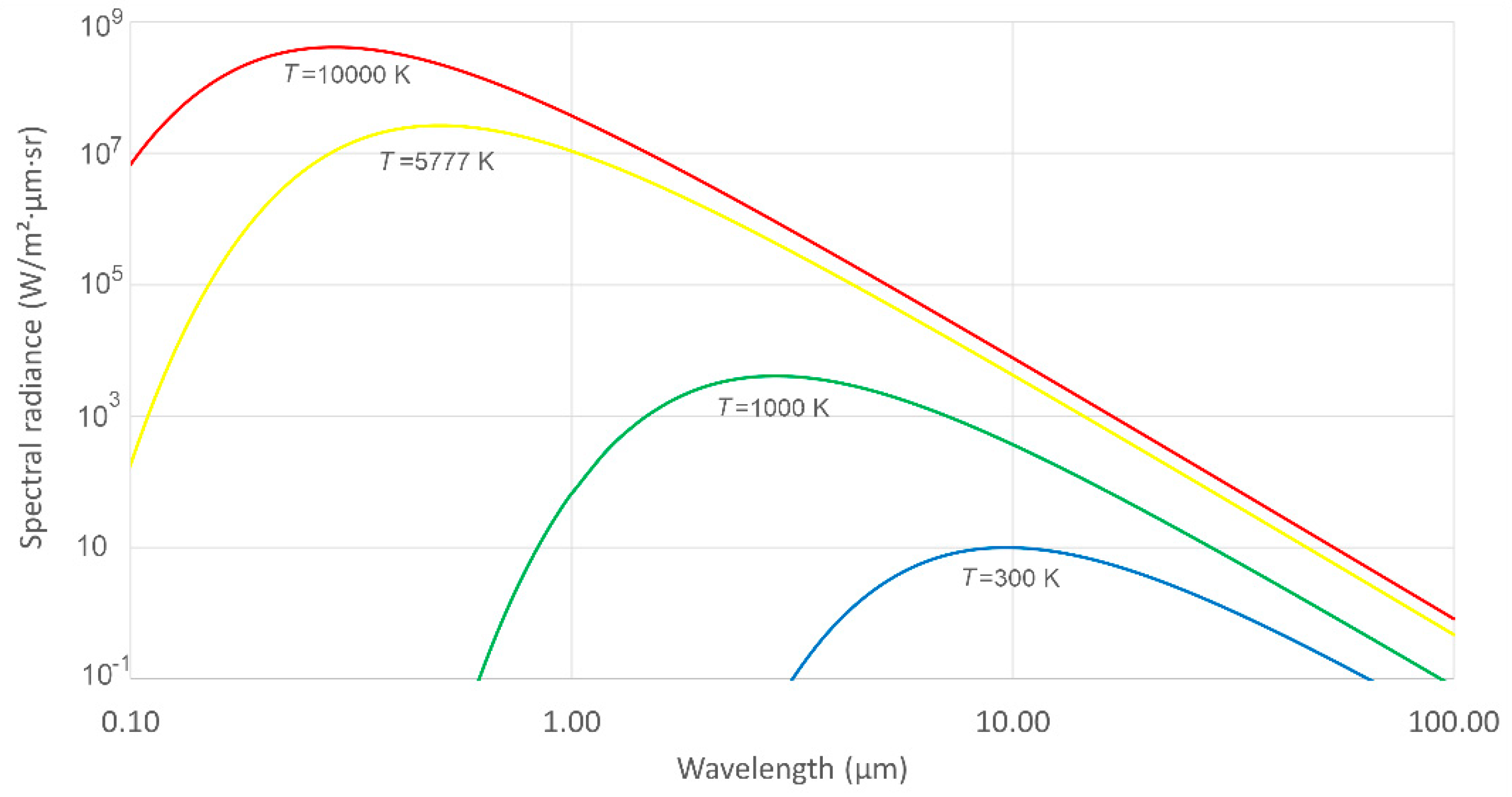
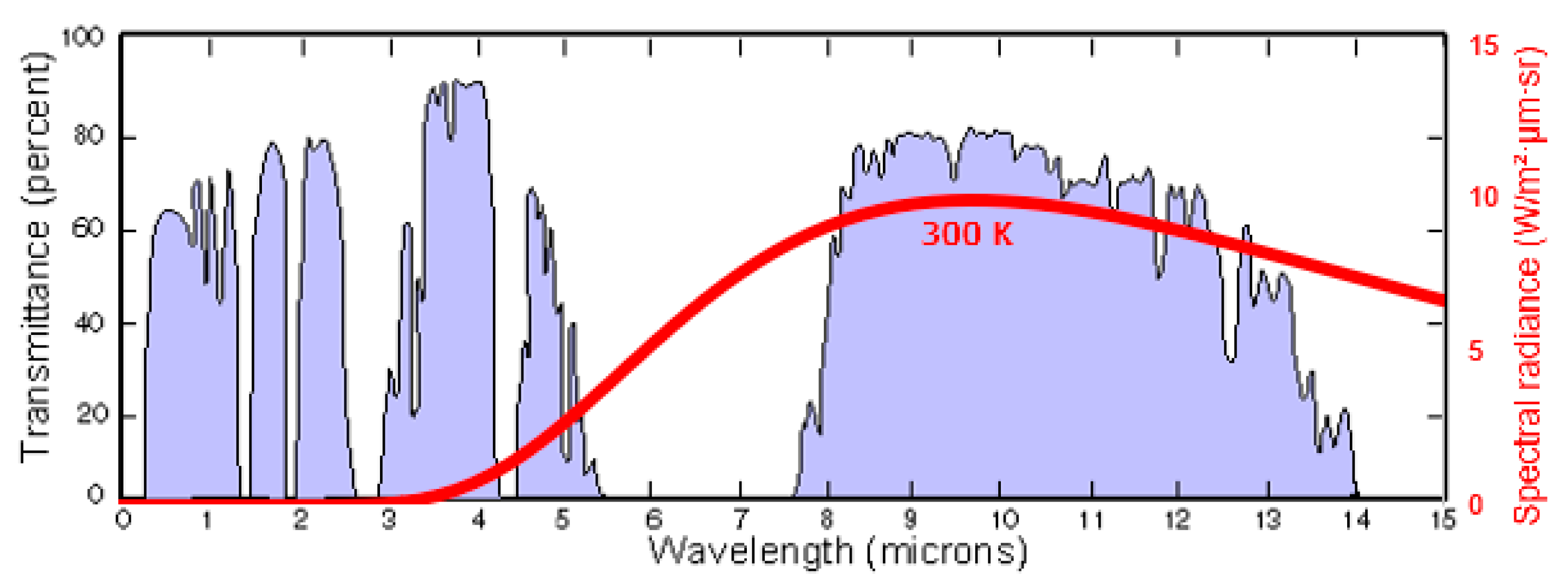
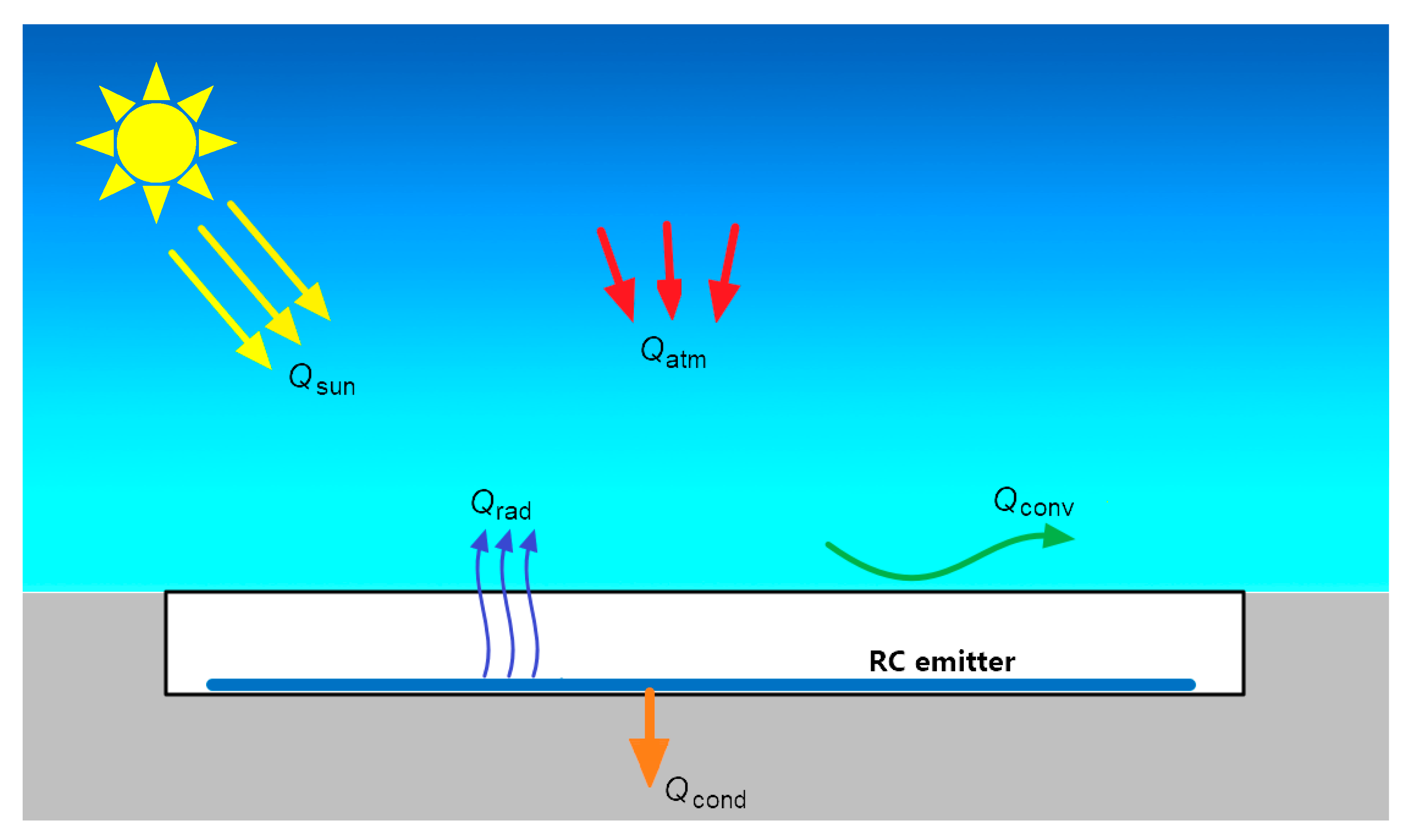
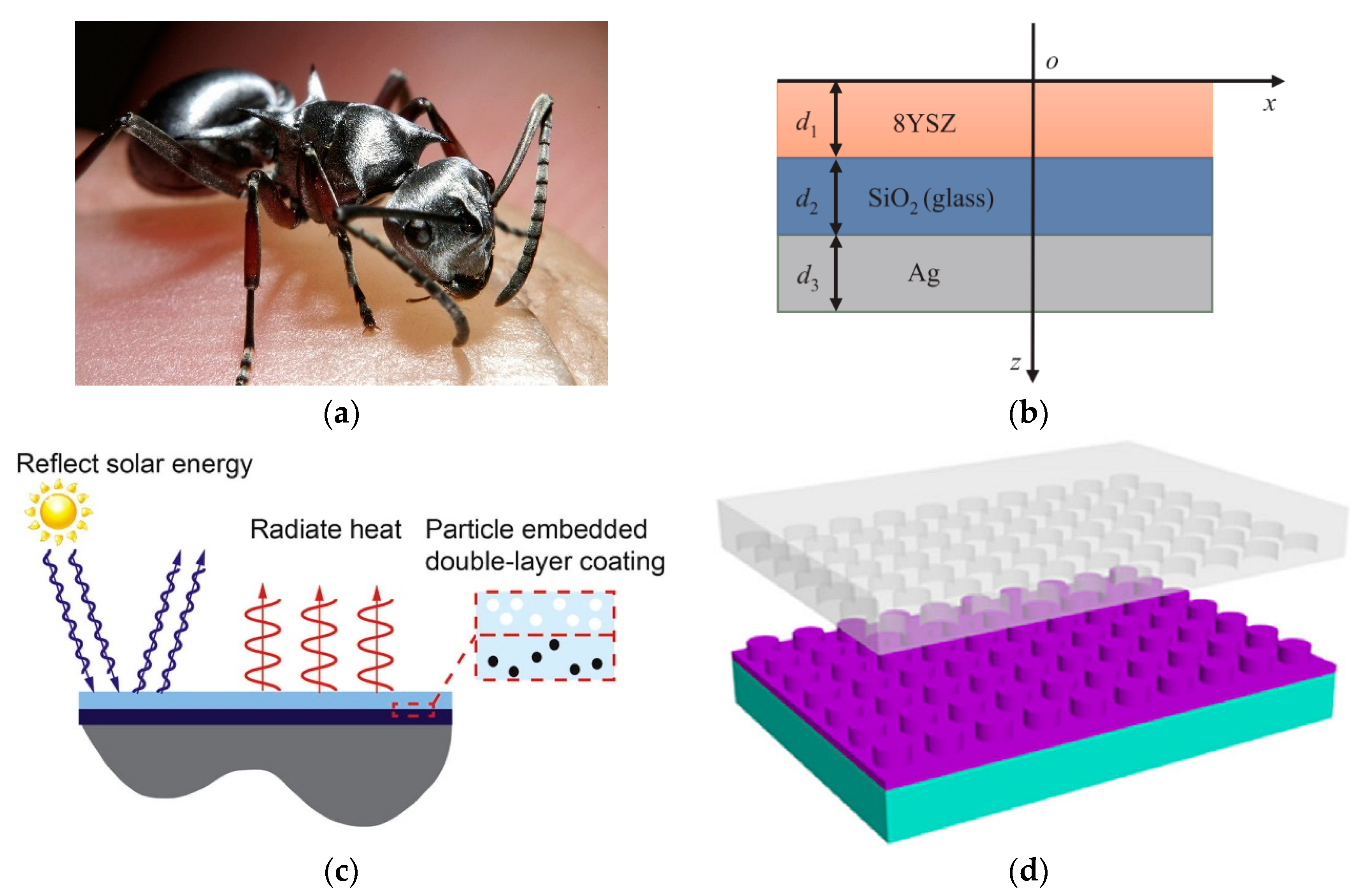

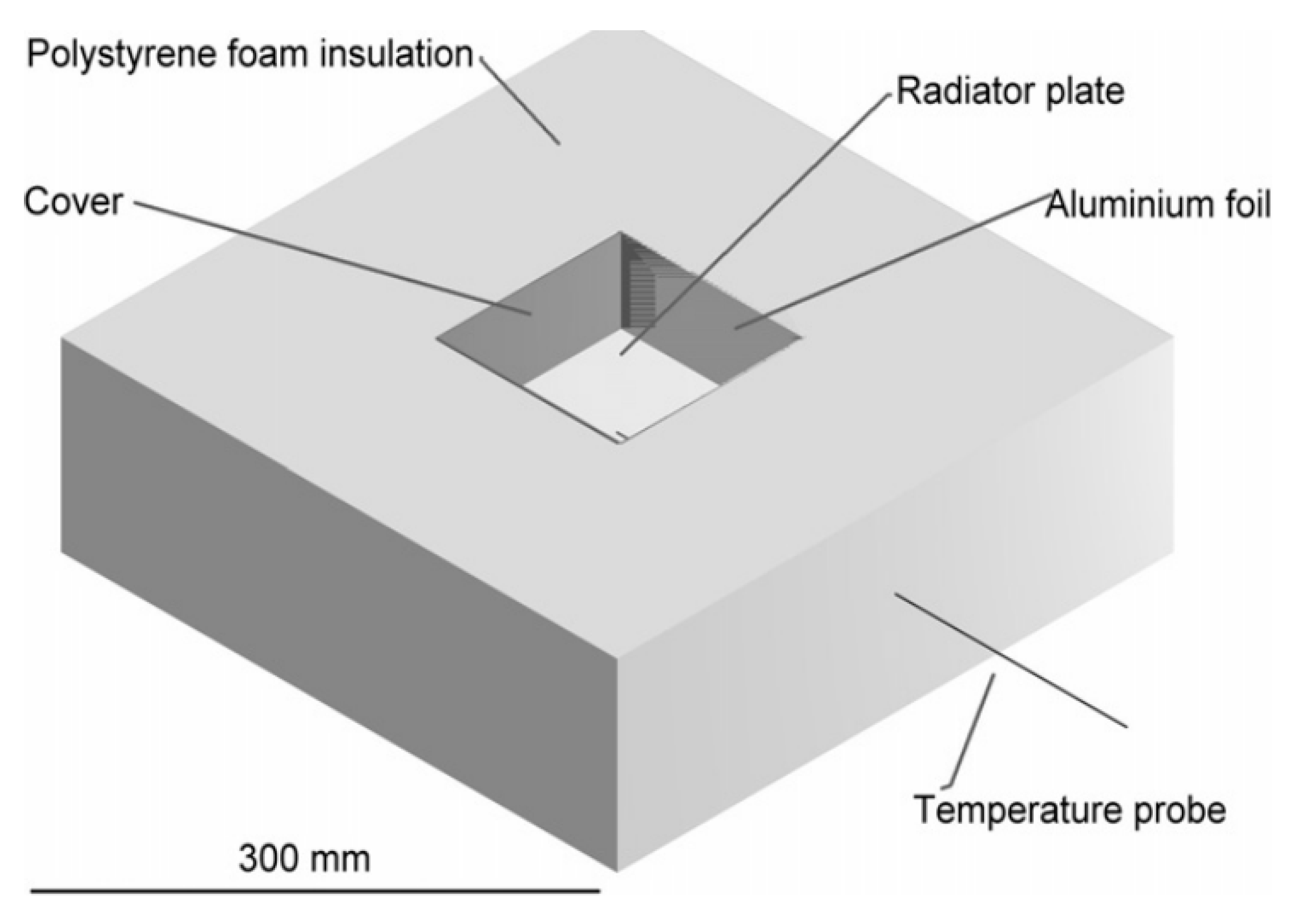
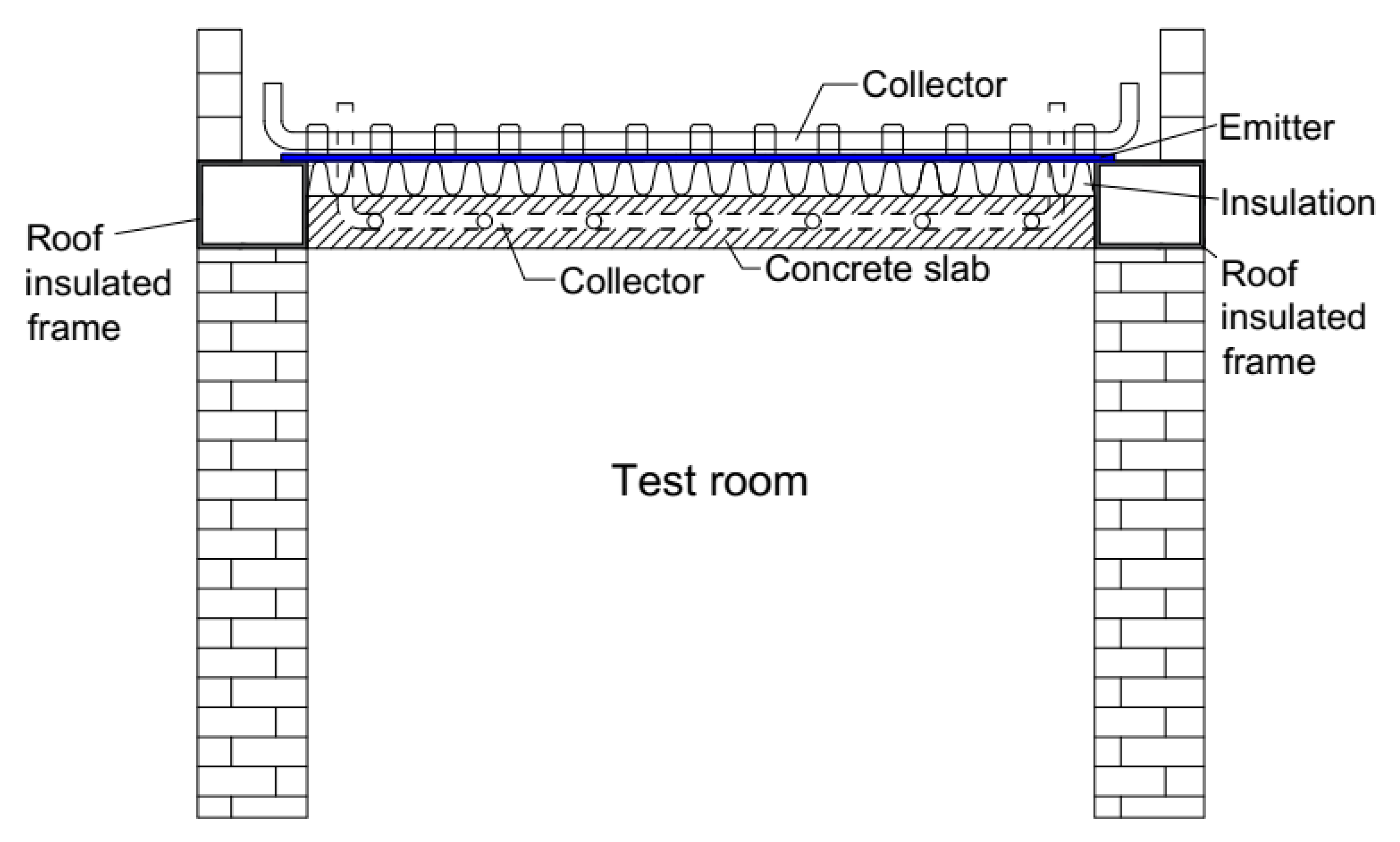
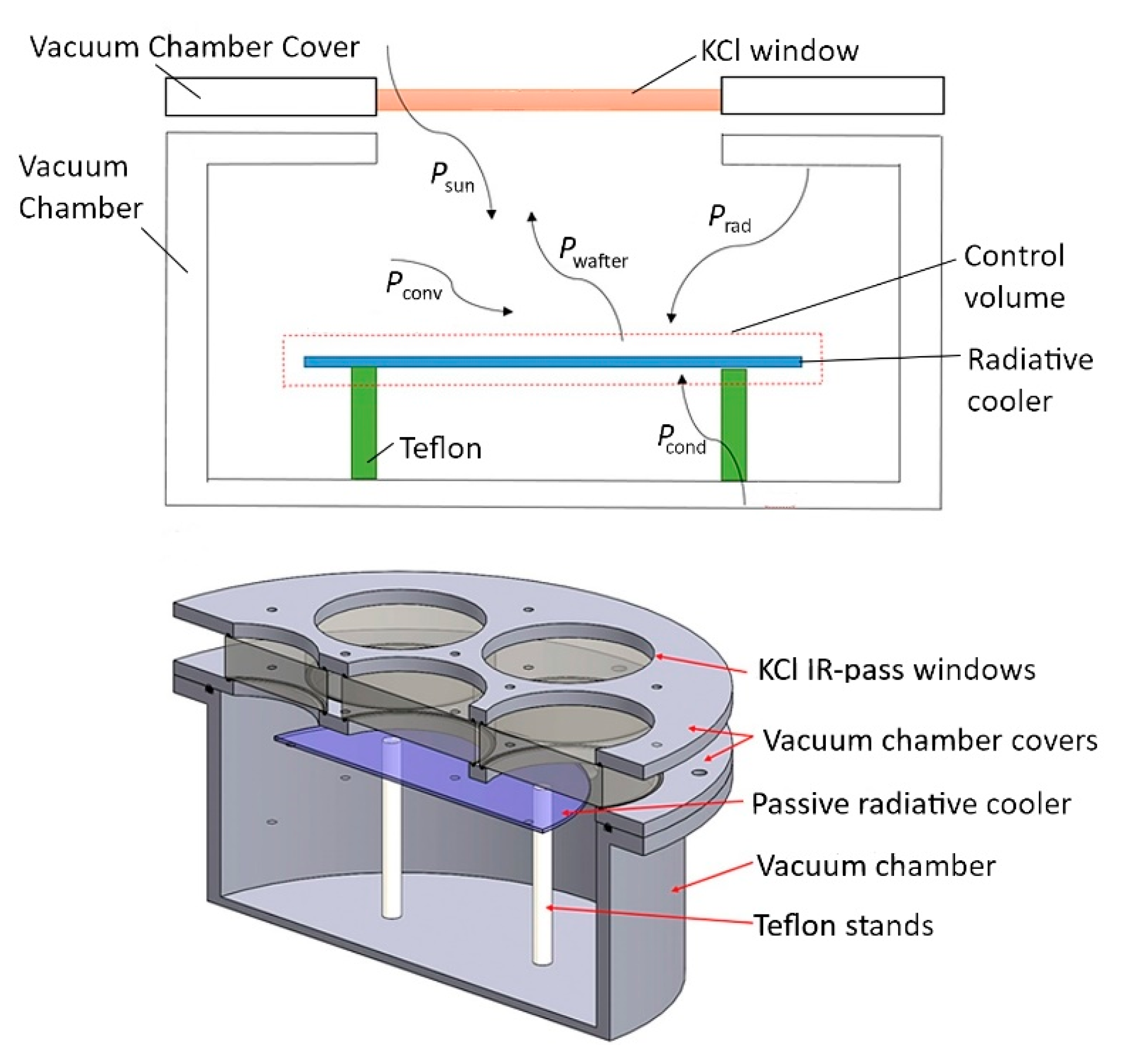



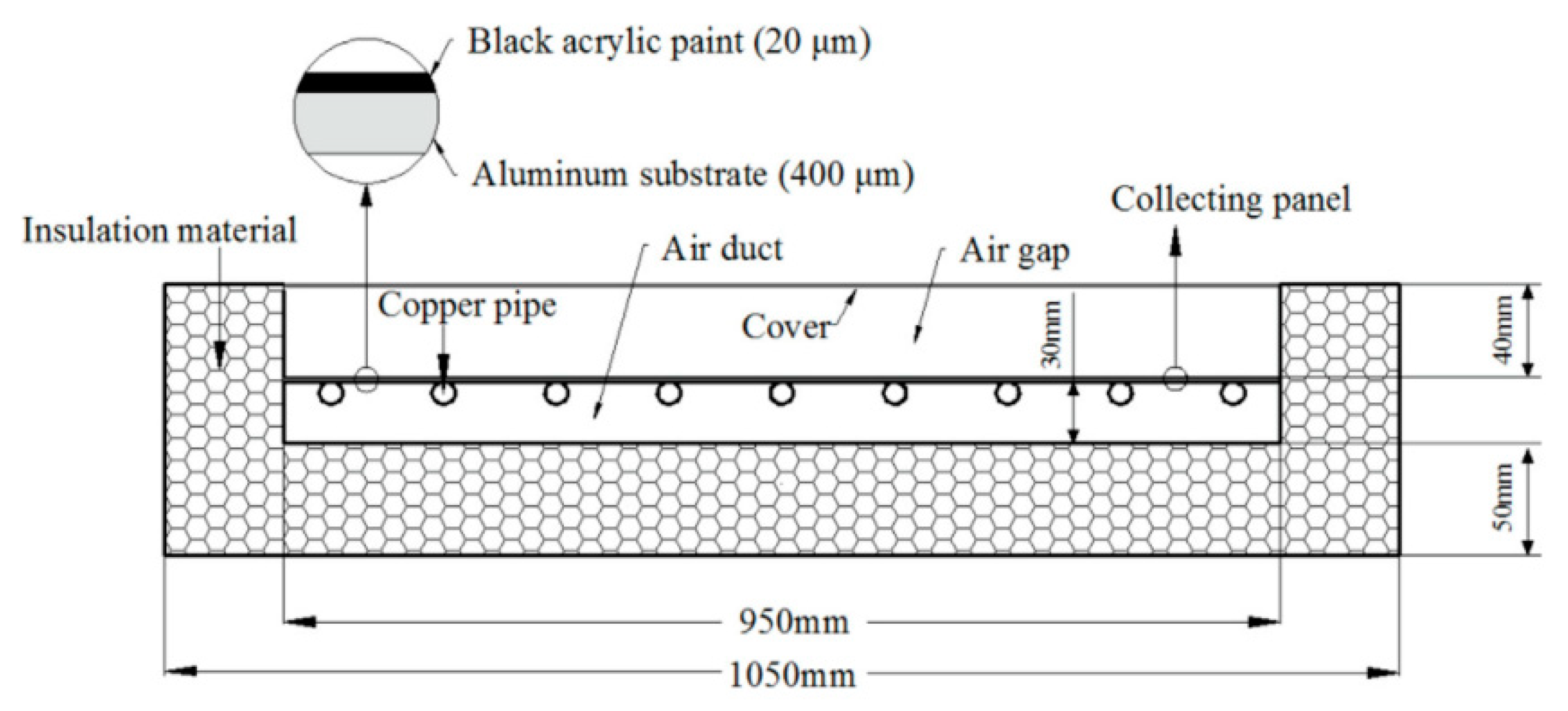

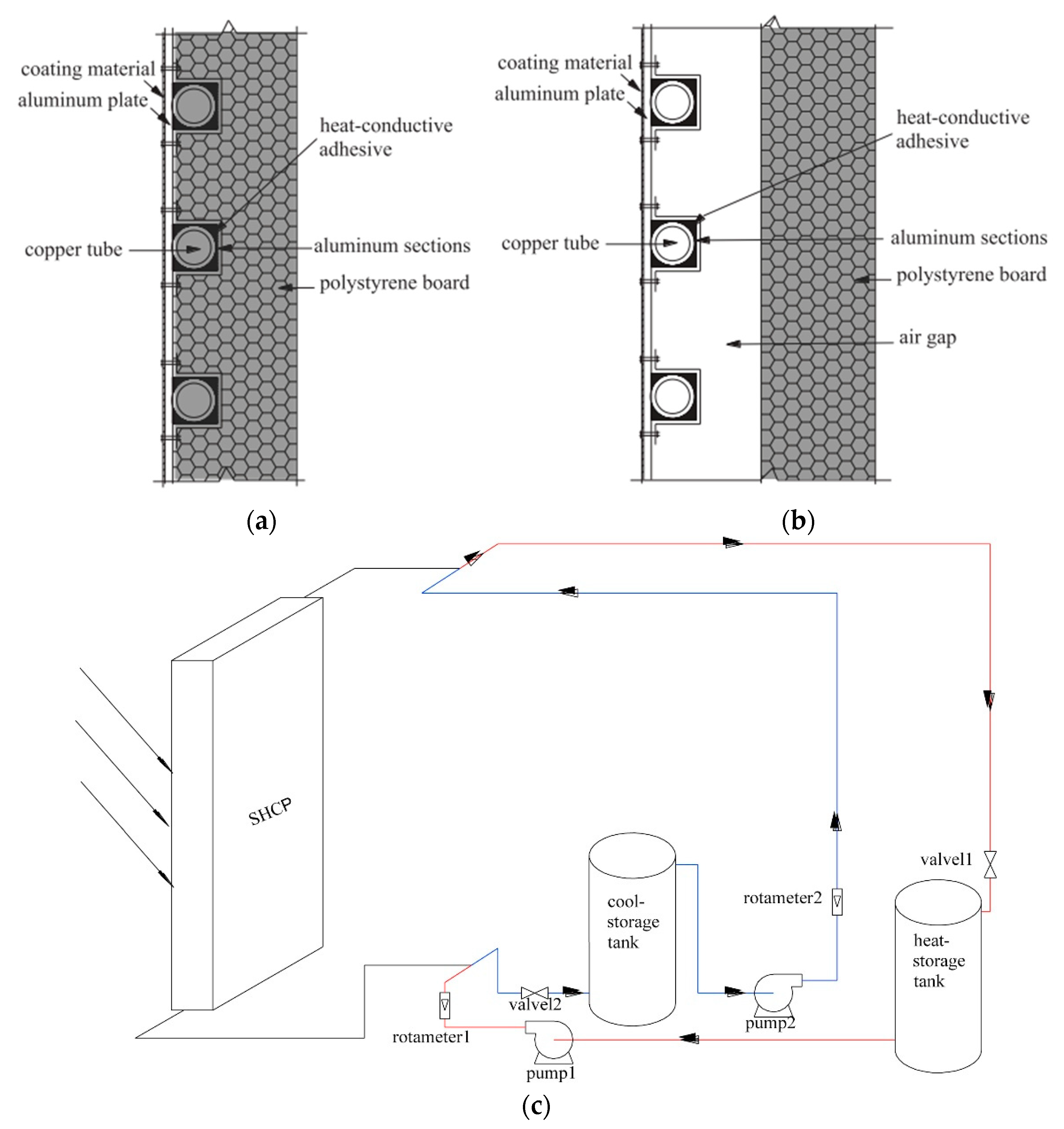
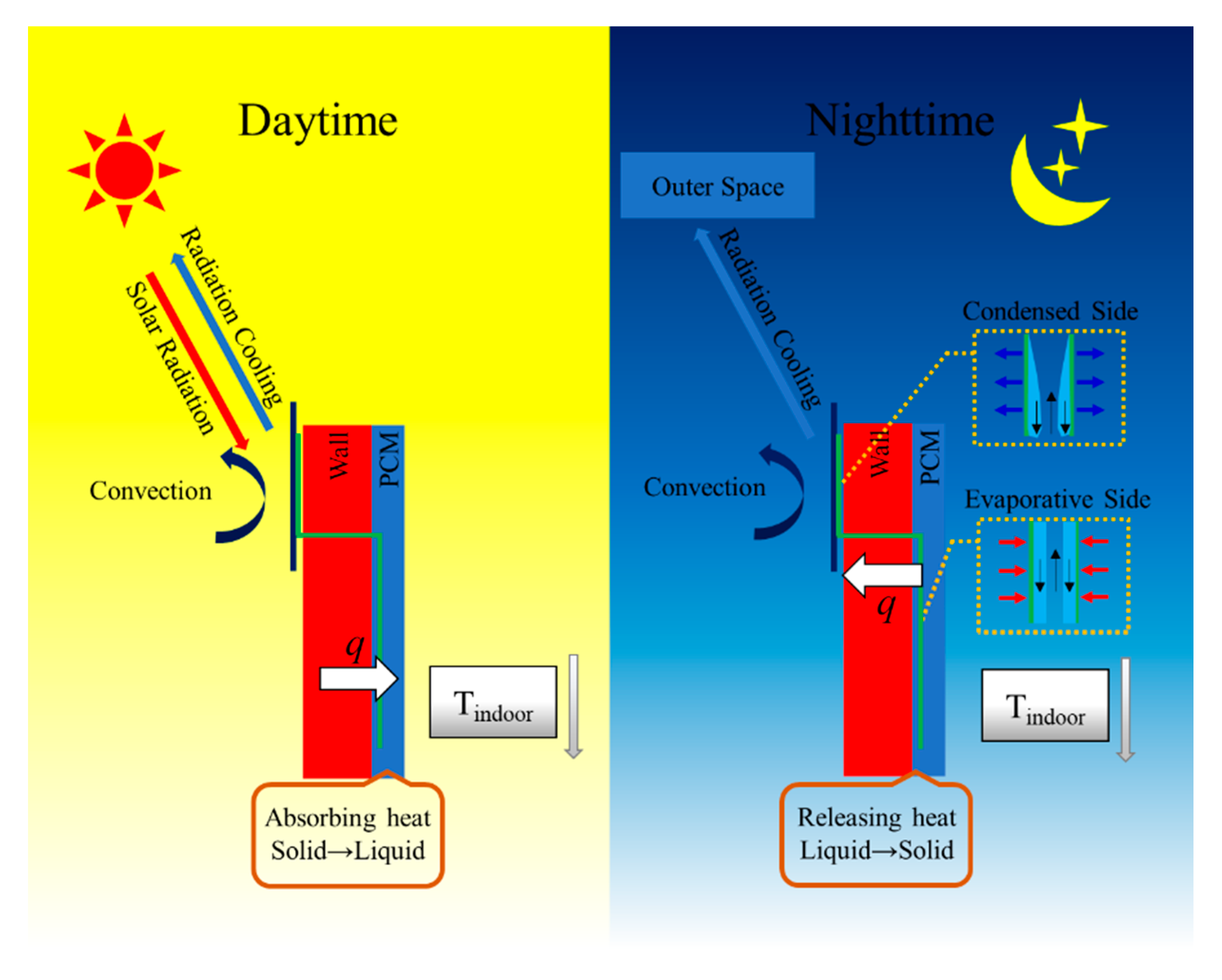

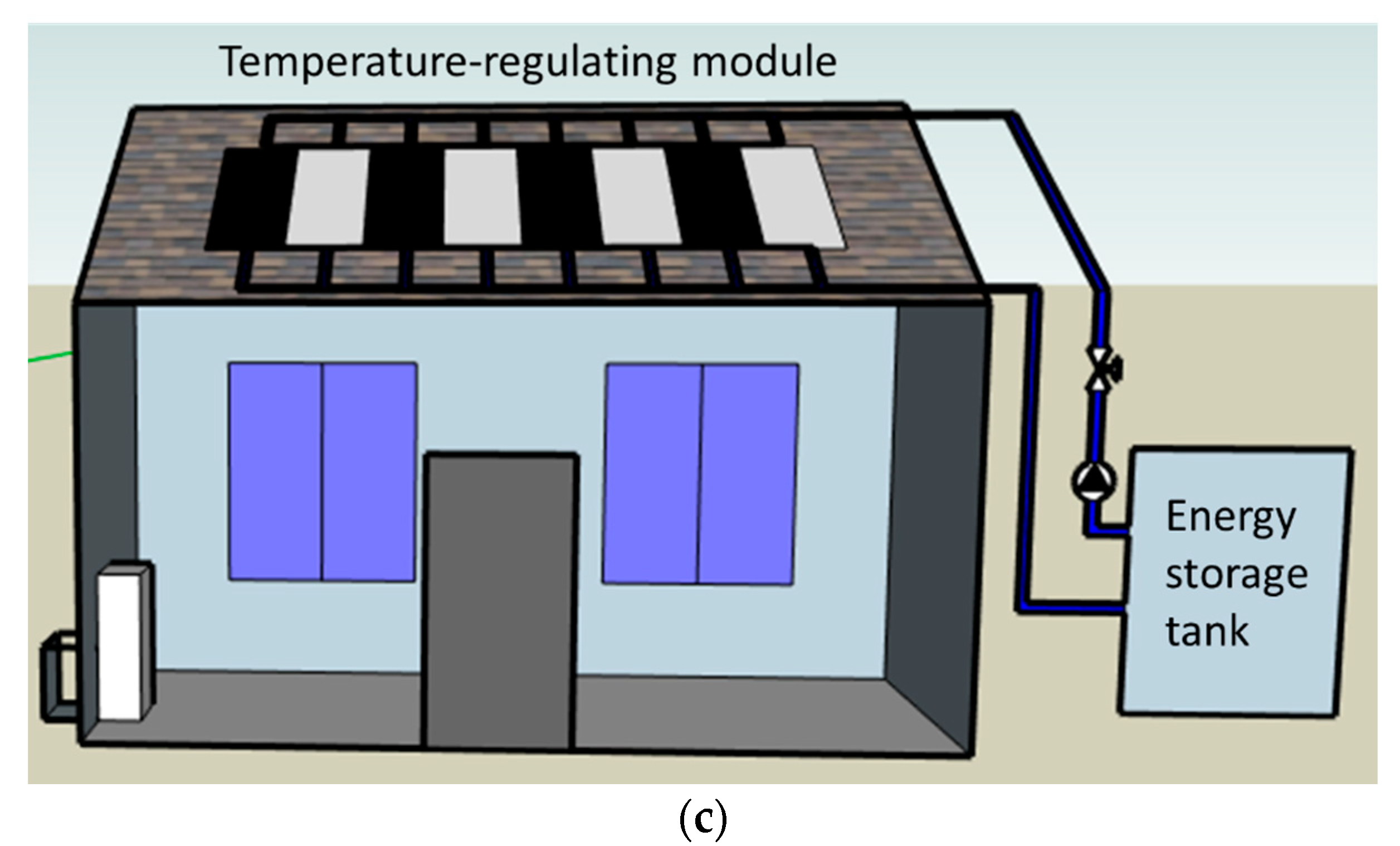
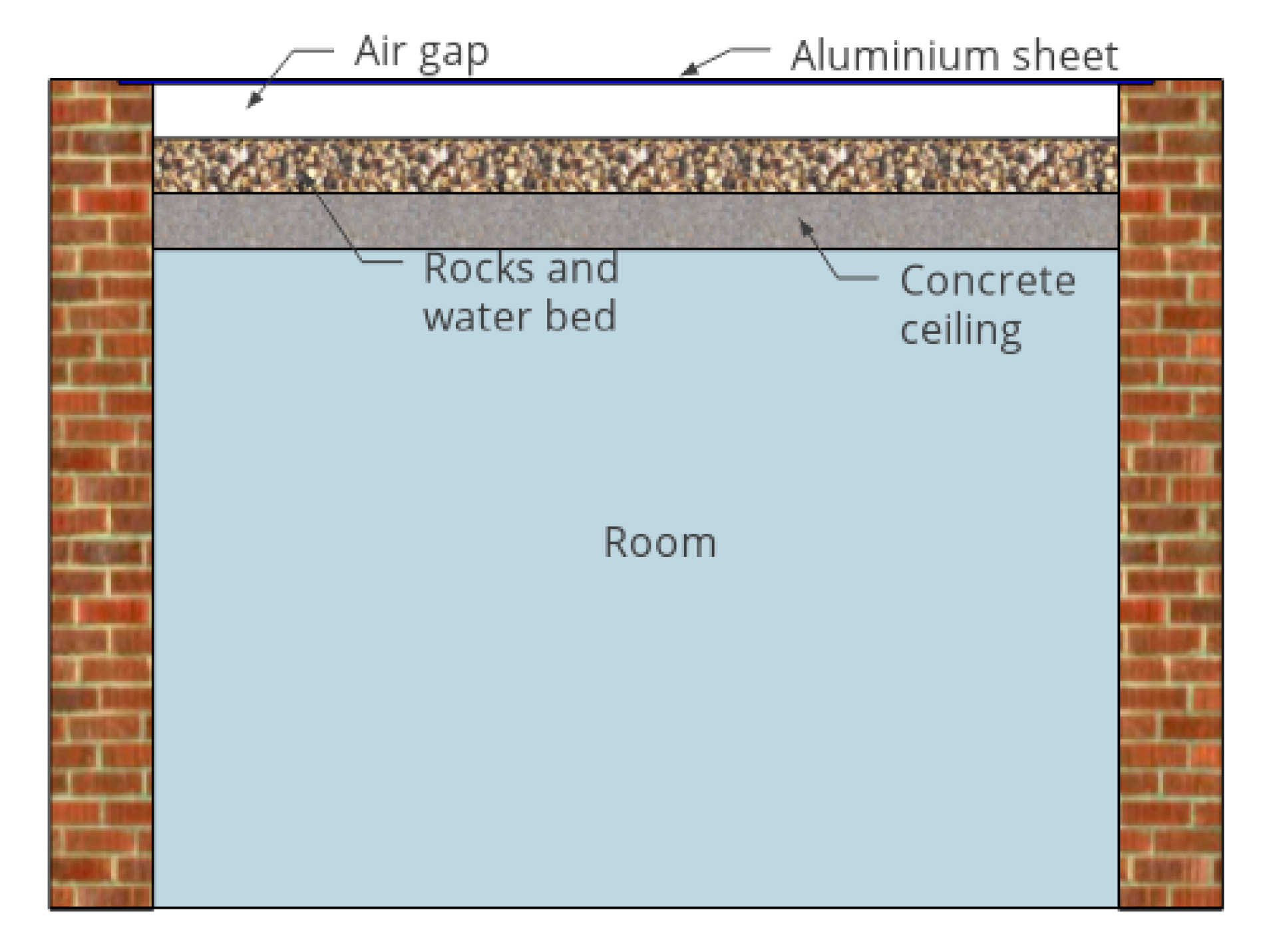
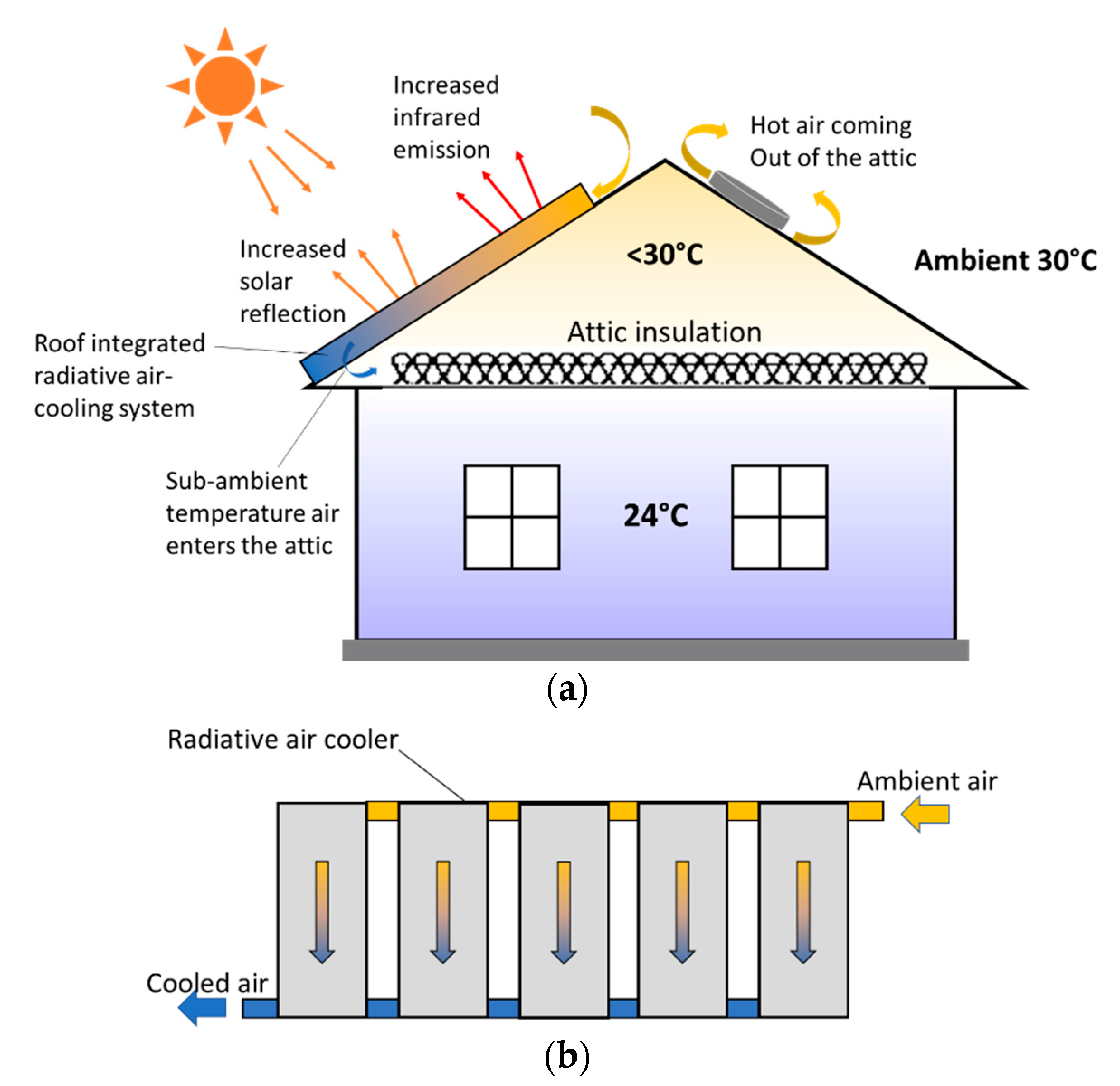
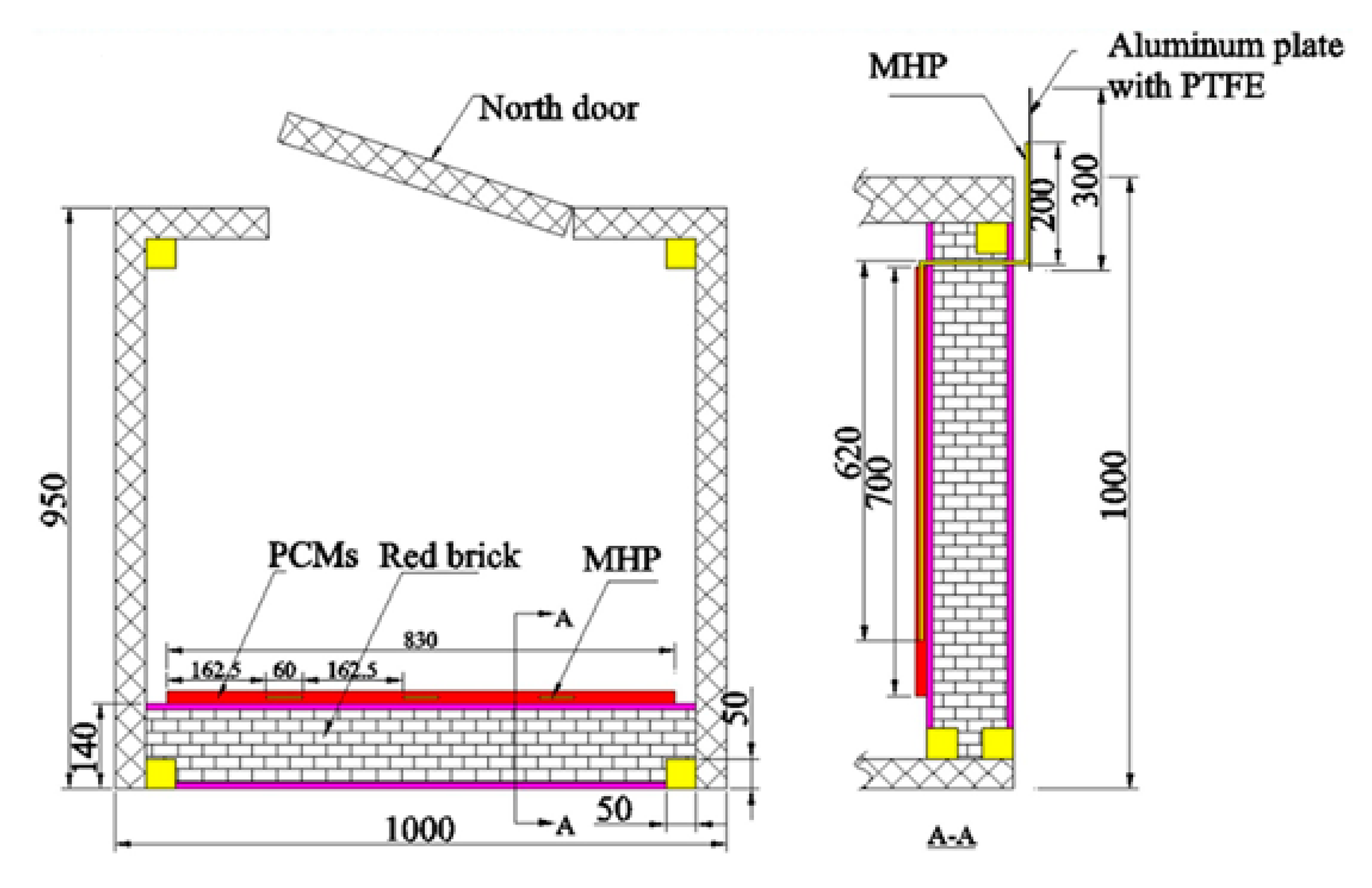
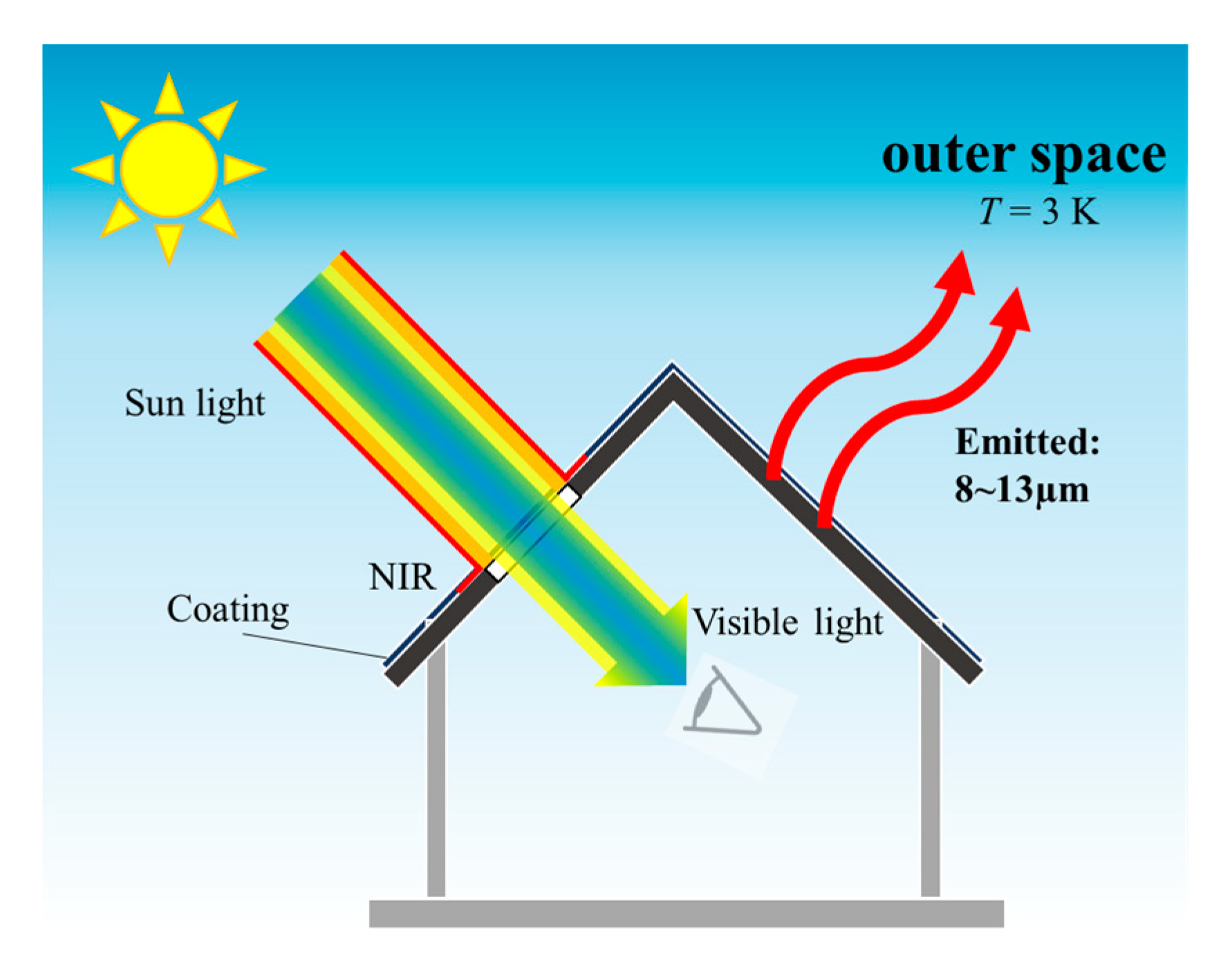
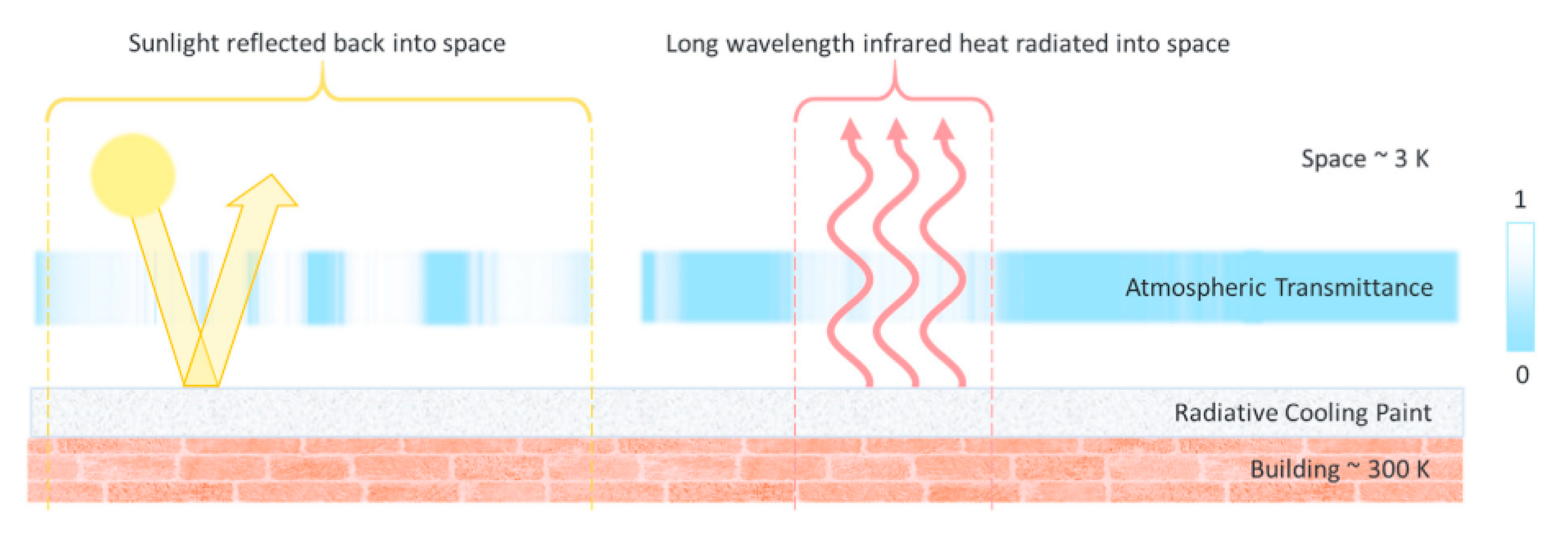
| Researcher | Category | Time | Improvement Strategy | Maximum Cooling Power/Minimum Temperature |
|---|---|---|---|---|
| [37] | Emitter material improvement | Nocturnal | Film-based emitter | energy saving for cooling up to 26–49% |
| [38] | Film-based emitter | 43 W/m2 | ||
| [39] | Photonic emitter | 5 °C below ambient | ||
| [40] | Photonic emitter | 5.2 °C below ambient | ||
| [41] | Diurnal | Film-based emitter | 120 W/m2 | |
| [42] | Film-based emitter | not available (N/A) | ||
| [43] | Film-based emitter | 2.5 °C below ambient | ||
| [8] | Film-based emitter | 4.2 °C below ambient | ||
| [44] | Film-based emitter | 95.1 W/m2 | ||
| [45] | Photonic emitter | 110 W/m2 | ||
| [46] | Nanoparticle-based emitter | 25.5 °C below ambient | ||
| [47] | Nanoparticle-based emitter | 35 °C below ambient | ||
| [48] | Photonic emitter | N/A | ||
| [49] | Photonic emitter | 14.3 W/m2 | ||
| [50] | Photonic emitter | 7.7 ± 0.2 °C below ambient | ||
| [51] | Cover material improvement | Nocturnal | Film-based cover | 23 W/m2 |
| [52] | Film-based cover | 175 W/m2 | ||
| [53] | Film-based cover | N/A | ||
| [54] | Film-based cover | N/A | ||
| [55] | Diurnal | Photonic cover | 50 W/m2 | |
| [56] | Design improvement | Nocturnal | Design aspect: water contact with the emitter, insulation | 97.8 W/m2 |
| [11] | Design aspect: construction material | 2.5 °C below ambient | ||
| [57] | Design aspect: water contact with the emitter | 52 W/m2 | ||
| [58] | Design aspect: air duct | 90 W/m2 | ||
| [59] | Design aspect: insulation, air duct | 2.5–4 °C below ambient | ||
| [60] | Design aspect: insulation | 38 W/m2 | ||
| [61] | Design aspect: insulation | N/A | ||
| [62] | Design aspect: cover, air duct | 1–6 °C below ambient | ||
| [63] | Diurnal | Design aspect: insulation | 37 °C below ambient through a 24 h cycle | |
| [64] | Design aspect: glazing and convection scheme | 100 W/m2 | ||
| [65] | Design aspect: orientation | 7.4 °C below ambient | ||
| [66] | Design aspect: appearance | 3.9 °C below ambient | ||
| [67] | Combination | Nocturnal | Trombe wall | energy saving for cooling up to 53% |
| [30] | Wall material | 55.8 W/m2 | ||
| [68] | Wall material and insulation, cold water storage | 87 W/m2 | ||
| [69] | Solar Collector, phase change material (PCM) | N/A | ||
| [70] | Photovoltaics (PV) | 128.5 W/m2 | ||
| [71] | Solar Collector | 50.3 W/m2 | ||
| [72] | Cold storage | N/A | ||
| [73] | Solar Collector | 27.3 W/m2 | ||
| [74] | PV, heating, ventilation, and air conditioning (HVAC) system | 123.9 W/m2 | ||
| [75] | PV | 41.7 W/m2 | ||
| [76] | HVAC | N/A | ||
| [77] | Solar Collector and PV, cold water storage | 75 W/m2 | ||
| [78] | PCM | energy saving potential can reach 77% for low-rise buildings | ||
| [79] | Desiccant | 5.5–7 °C below ambient | ||
| [34] | Solar Collector, desiccant | energy saving up to 7400 kWh per year | ||
| [80] | PV, solar collector, HVAC | N/A | ||
| [81] | HVAC | energy saving for cooling up to 46% for | ||
| [82] | Radiant cooling, air handling unit (AHU) | 18.1 W/m2 | ||
| [83] | Fan or HVAC | 5–10W/m2 | ||
| [84] | Ground coupled heat pump | energy saving 10.22% compared to conventional ground heat pump | ||
| [85] | PV, solar collector | 72 W/m2 | ||
| [86] | HVAC | N/A | ||
| [87] | Thermosyphon and cold water storage | energy saving for cooling up to 8% | ||
| [88] | Solar Collector | 36.61 W/m2 | ||
| [32] | Heat pipe | 14.5 W/m2 | ||
| [17] | Photovoltaic thermal (PV/T) | 65 W/m2 | ||
| [89] | Thermosyphon and cold water storage | N/A | ||
| [25] | Solar Collector | 4–5 °C below ambient | ||
| [90] | Solar Collector | 55.1 W/m2 | ||
| [91] | Solar Collector | 40 W/m2 | ||
| [33] | Thermosyphon and cold water storage | 15 °C below ambient | ||
| [31] | Thermal mass | 77.2 W/m2 | ||
| [92] | PV | 72.94 W/m2 | ||
| [93] | Solar Collector, HVAC | 4.7 °C below ambient | ||
| [94] | Water tank | 8.4 °C temperature reduction | ||
| [95] | Diurnal | HVAC | 16 W/m2 | |
| [96] | HVAC | more than 200 W/m2 | ||
| [97] | Thermoelectric, cold water storage tank | daytime and nighttime cooling of the radiative sky cooling subsystem contribute to 55.0% and 45.0% of annual cold generation, respectively | ||
| [98] | Attic insulation | energy saving for cooling up to 3.7–11.8 kWh/m2 | ||
| [99] | Cold water storage, radiant cooling in the room | 12.5 W/m2 | ||
| [100] | PCM, thermosyphon | energy saving for cooling up to 25% | ||
| [101] | PCM, wall material | energy saving for cooling up to 47.9% | ||
| [102] | PCM, cold water storage | energy saving for cooling up to 10% | ||
| [103] | Wall material and insulation | 50 W/m2 on the wall, and 120 W/m2 on the roof | ||
| [104] | Shading device | reduces solar gain by up to 40% | ||
| [105] | Glazing | energy saving for cooling between 40.9–63.4% |
| Researcher | Architectural Feature | Means of Implementation | Combination | |
|---|---|---|---|---|
| [25] | Roof | Passive system | Air-based | Solar Collector |
| [31] | Air-based | Thermal mass | ||
| [30] | Air-based | Thermal mass | ||
| [98] | Air-based | Attic Insulation | ||
| [94] | Water-based open system | Water tank | ||
| [93] | Active system | Air-based | Solar Collector, HVAC | |
| [83] | Air-based | Fan or HVAC | ||
| [79] | Air-based | Desiccant | ||
| [34] | Air-based | Solar Collector, Desiccant | ||
| [80] | Air-based | PV, Solar Collector, HVAC | ||
| [74] | Air-based | PV, HVAC | ||
| [75] | N/A | PV | ||
| [76] | Water-based closed system | HVAC | ||
| [77] | Water-based closed system | Solar Collector and PV, cold water storage | ||
| [78] | Water-based closed system | PCM | ||
| [81] | Water-based closed system | HVAC | ||
| [82] | Water-based closed system | Radiant cooling, HVAC | ||
| [84] | Water-based closed system | Ground coupled heat pump | ||
| [85] | Water-based closed system | PV, Solar Collector | ||
| [86] | Water-based closed system | HVAC | ||
| [87] | Water-based closed system | Thermosyphon and cold water storage | ||
| [32] | Water-based closed system | Heat pipe | ||
| [17] | Water-based closed system | PV, Solar Collector | ||
| [89] | Water-based closed system | Thermosyphon and cold water storage | ||
| [90] | Water-based closed system | Solar Collector | ||
| [33] | Water-based closed system | Thermosyphon and cold water storage | ||
| [95] | Water-based closed system | HVAC | ||
| [96] | Water-based closed system | HVAC | ||
| [99] | Water-based closed system | Cold water storage | ||
| [102] | Water-based closed system | PCM, Cold Water Storage | ||
| [88] | N/A | Air-based | Solar Collector | |
| [92] | N/A | PV | ||
| [103] | Roof and Wall | Passive system | Air-based | Wall material and insulation |
| [112] | Passive or active | Air or water-based | Temperature-regulating module | |
| [113] | Wall | Passive system | Air-based | Trombe wall |
| [67] | Passive system | Air-based | Trombe wall | |
| [100] | Passive system | Water-based closed system | PCM wall | |
| [101] | Passive system | Water-based closed system | PCM wall | |
| [68] | Active system | Water-based closed system | Wall material and insulation, cold water storage | |
| [105] | Window or skylight | Passive system | Air-based | Glazing material |
| [114] | Passive system | Air-based | Glazing material | |
Publisher’s Note: MDPI stays neutral with regard to jurisdictional claims in published maps and institutional affiliations. |
© 2020 by the authors. Licensee MDPI, Basel, Switzerland. This article is an open access article distributed under the terms and conditions of the Creative Commons Attribution (CC BY) license (http://creativecommons.org/licenses/by/4.0/).
Share and Cite
Suhendri; Hu, M.; Su, Y.; Darkwa, J.; Riffat, S. Implementation of Passive Radiative Cooling Technology in Buildings: A Review. Buildings 2020, 10, 215. https://doi.org/10.3390/buildings10120215
Suhendri, Hu M, Su Y, Darkwa J, Riffat S. Implementation of Passive Radiative Cooling Technology in Buildings: A Review. Buildings. 2020; 10(12):215. https://doi.org/10.3390/buildings10120215
Chicago/Turabian StyleSuhendri, Mingke Hu, Yuehong Su, Jo Darkwa, and Saffa Riffat. 2020. "Implementation of Passive Radiative Cooling Technology in Buildings: A Review" Buildings 10, no. 12: 215. https://doi.org/10.3390/buildings10120215
APA StyleSuhendri, Hu, M., Su, Y., Darkwa, J., & Riffat, S. (2020). Implementation of Passive Radiative Cooling Technology in Buildings: A Review. Buildings, 10(12), 215. https://doi.org/10.3390/buildings10120215








